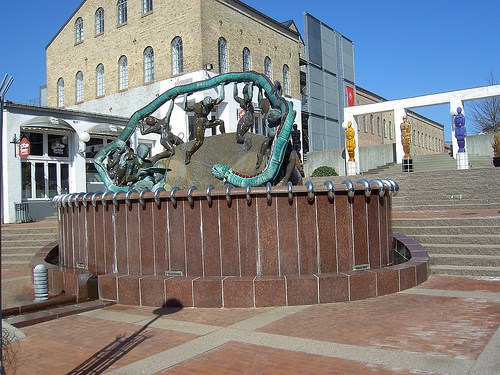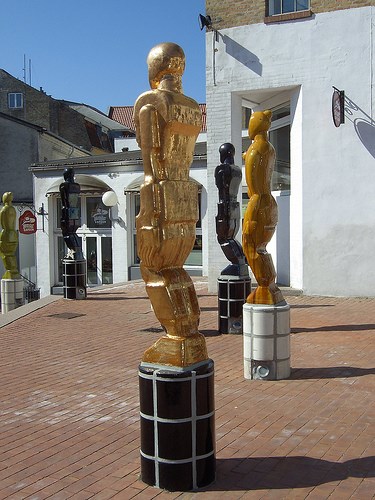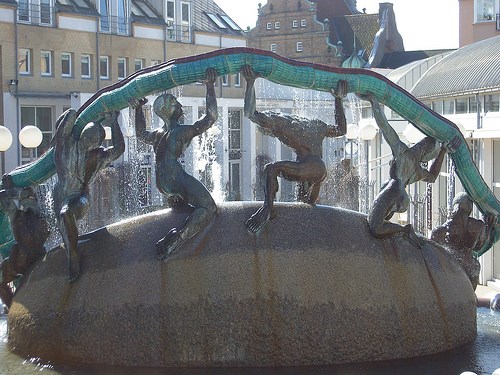P. Nørkjærs Plads (by the museum)
Architect Kjeld Bjerg & Professor Bjørn Nørgaard
It all begins in the street outside P. Nørkjærs Plads (square) with a large richly coloured portal with glazed tiles. If you are persuaded to go beyond the portal, you are met by a surprising city room in the heart of Hjørring. A room and a square dramatically staged by the sculptor, Professor Bjørn Nørgaard. It all its might it suggests a big complete work of art of Wagnerian dimensions.
P. Nørkjærs Plads was inaugurated on 5 June 1989. The square is called after Mr. Peter Nørkjær who financially made the project possible. Mr. Nørkjær was one of Hjørring's very first car dealers. He began as farrier with a training place at the blacksmith in Try at the beginning of the century - and ended as car dealer with a thriving business in Hjørring. Before his death Mr. Nørkjær collected his fortune in a foundation and though a donation from this foundation his sons commemorate their father. Thus, the large project is entirely a result of private initiative and accomplished with private money only as the city has not participated with ideas nor financing.
The square is 1600 square meters, and the buildings are by the architect Mr. Kjeld Bjerg, while the grounds are by Professor Nørgaard. The new buildings frame the square and the fountain. At night a radiant purple band is lit, running in the lines of the buildings, and the fountain is bathed in light. Professor Nørgaard's mega work of art is a very extensive staging with a veritable abundance of mythological references, all of it organized by means of historical and geometrical basic forms.


The square is somewhat cramped and Professor Nørgaard fills it to the bursting point. It is constructed around a central and almost symmetrical axis with a confusion of tortuous tales inserted in one another. The actual fountain consists of a main reservoir from where the water runs in a straight axis through three smaller ponds. The water also play vertically in rhythmical intervals. The 33 meters long watercourse is formed as a classical geometrical idiom, ending in an almost 5 meters tall obelisk next to a 1 meter runic stone. An irregular granite band runs around the obelisk and at the top sits a stylized bronze head. The runic stone is roughly cut without readable runes. Here the water flow quietly. However, in the large main reservoir the water roars - and this is where the main story takes place.
Six turned bronze figures (three men and three women) carry a shining green Midgårdsorm (the large serpent from the Nordic mythology) with two heads, the animal spewing its venom over poor Loke. Sigyn tries to catch the venom in a basin – and depending on the wind conditions she succeeds in saving her husband from being hit by the scorching venom. The large block of granite in the main reservoir obviously is the Earth around with the serpent squirm and the mythological scene takes place.
In the middle of the scenery you will find a man without any
direct relation to the Nordic mythology. A shepherd, a pilgrim or maybe a priest standing unaffected in the middle of the colossal story, looking as if nothing has happened. Here undisguised Christian references are mixed with the mythology. Behind the main reservoir is a round arch with 13 stylized female and male figures, one of them gilded and luminous in the middle – Jesus and the 12 apostles are behind it all. Despite the female forms the 13 figures are so stylized that they most of all look like some of the robots from Star Wars. Thus, the references goes far back in history and very much forward as well.
Professor Nørgaard mixes the Christian cultural inheritance with the Nordic mythology, just as he mixes a number of material: Granite, bronze, tiles, flagstones, water, marble etc. And on top of that there is a water ballet: The long watercourse has built-in music, especially composed for the fountain. 10 minutes before every hour the music is heard on the square, the water playing in step with the music.
The total theatre plays with a number of material and has numerous cultural references, for instance from the Danish cultural inheritance. Thus, the fountain is not only one of Professor Nørgaard's big achievements, but also a beautiful entrance to one of the large cultural institutions of the city - an institution with the task to safeguard the cultural inheritance of North Jutland on behalf on the pictorial art.


